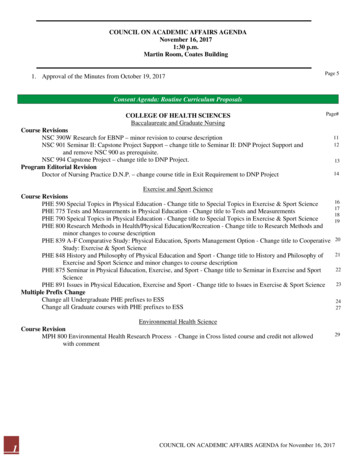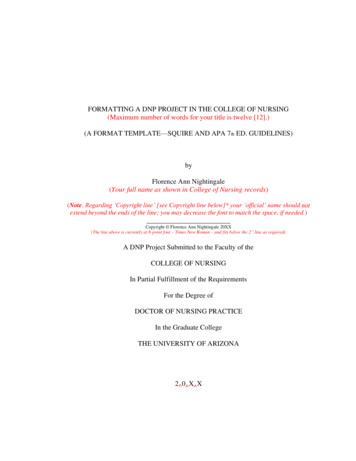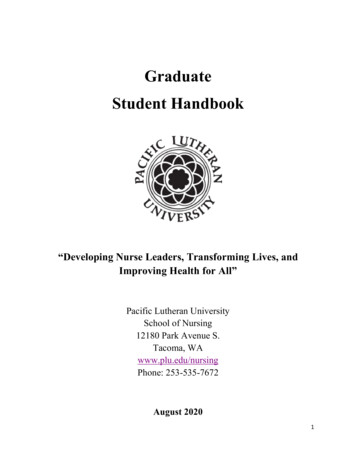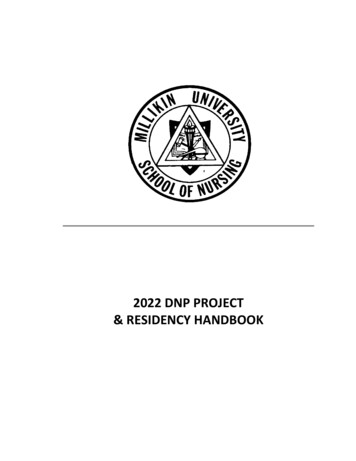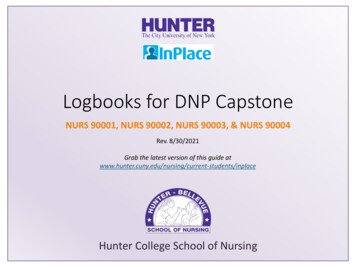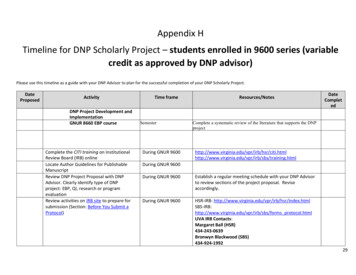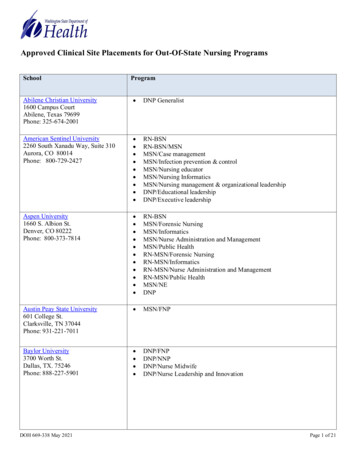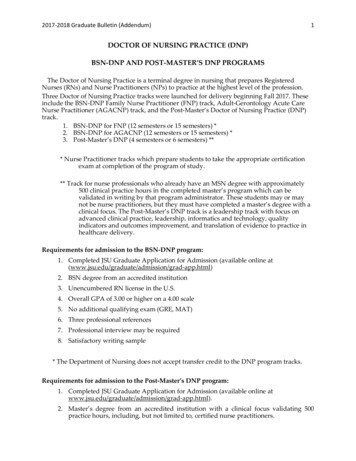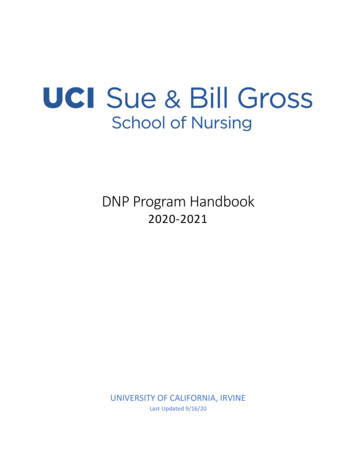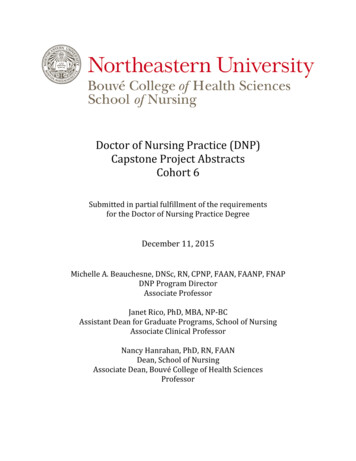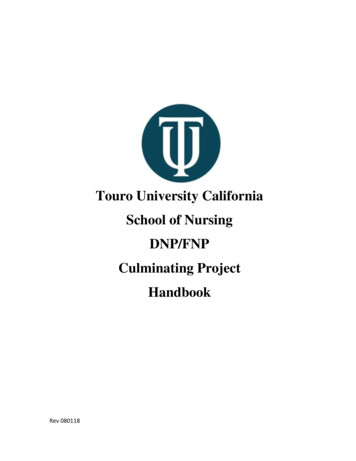
Transcription
EXAMPLE OF ADNP CAPSTONEPROJECT
EXAMPLE OF DNP CAPSTONEPROJECTPUBLIC HEALTH - DEFINITION AND INTRODUCTIONPublic health is a science for the protection and improvement of health inevery society through health education, the promotion of a healthy lifestyle,as well as through disease research and injury prevention. For these reasons,in this first chapter, our fundamental goal is with a scientific approach touncover the essence of modern public health, its scope and content. Thisrefers above all to scientific public health issues that will greatly help publichealth professors to explain their ideas to students in order to strengthentheir academic work. Knowledge of public health will allow you to discoverproblems and determine health care needs.Following the modern trends in the field of health and health care, publichealth can be defined as a social, economic and political-legal conceptaimed at financing health and health care, improving health, extending lifeand improving the quality of the life of the entire population through healthpromotion, disease prevention and other forms of public health activities andinterventions. Throughout the literature, the terms of classical public healthand new public health will be met in relation to goals for assessingachievements, in describing and analyzing determinants of health, as well asin methods of solving health problems. The new public health is, in itsessence, differentiated with a full understanding of the ways in whichlifestyles and living conditions affect health status, as well as recognizingresource mobilization needs and proper investment in policies, programs andservices that create, maintain, and protect health by supporting healthylifestyles and creating a healthy environment. Such a difference betweenclassical and new public health may not be needed in the future whendeveloping the spectrum of public health.
But for more successful learning of the science, students need to know theevolution of public health and to understand the similarities and differencesbetween classical and new public health, which will become a later word.However, public health includes all possible activities and alternatives thatwould be beneficial and effective for health promotion, as well as for theprevention, treatment and rehabilitation of diseases of the individual, societyand the target population. In the past, the terms for public health labelingwere used: social hygiene, preventive medicine, community medicine, socialmedicine and others.Preventive medicine is a combination of elements of public health andclinical medicine. Public health, as well as a public health professional inclinical medicine, deals with the individual, such as in immunization programs.And clinical medicine works in the field of prevention in patients withhypertension or diabetes and hence prevents serious complications fromthese diseases. Preventive medicine focuses on medical or clinical activities,or what can be called individual preventive care, with an emphasis oncommunity risk groups and national health promotion efforts (Tulchinsky &Varivikova 2000, p. 81).As for prevention, it covers all measures and activities that aim at eradication,elimination, or reduction of the impact of disease and disability. Prevention ofvarious diseases requires a good knowledge of the ecological development,that is, the epidemiological process. The concept of prevention can best bedefined through levels and methods of prevention, traditionally termedprimary, secondary, and tertiary prevention. Primary prevention means theprevention, avoidance or reduction of the occurrence of a particular disease.Secondary prevention means the prevention, deterioration or complicationsof an emerging disease or condition. Tertiary prevention involves providingmaximum degree of healing and restoring maximum functions. All thesepreventive activities are interconnected and dependent on each otherbecause of their complexity. When defining the goal of disease prevention,the next step is to identify appropriate and complete methods for achievingit, or to develop a strategy with tactical goals. It defines the measures of workand the means necessary for reaching the goal.
Public health aims to improve well-being, promote positive health andprevent disease. Hence, the main focus of public health is health and diseaseprevention.This is achieved through the following activities:Prevention of epidemics and spread of diseases;Protection from a hazardous environment;Prevention of injuries;Promoting and encouraging healthy behavior;Responding to natural and social disasters and helping the community inits healingQuality assurance and access to public health servicesThe conclusion is that public health is a complex science that deals with thepreservation and improvement of the health of the population through healtheducation, the promotion of healthy living habits and the research of diseasesand the prevention of injuries. Also, public health involves the application ofseveral scientific disciplines, such as: biology, sociology, mathematics,anthropology, politics, economics, medicine, psychology, informatics,engineering, management and others. As we said before, public health couldhardly be described. But we would probably group public health in the healthand medical profession. Our health is supported by public health. Medicalprofessionals provide us with health care whenever we need it. We visit thesame because of the need for annual controls and vaccinations or to betreated by certain diseases. In contrast, public health professionals work toprevent health problems that affect most of the population. For example,public health professionals educate society on infectious diseases andepidemics, such as Aids, in order to minimize the consequences. Medicalprofessionals work with individual patients, and public health professionalsfocus on society as a whole. Medical professionals concentrate ondiagnosing and treating specific diseases of individual patients, while publichealth professionals emphasize prevention and health promotion usingnumerous interventions that affect the environment, public policy and humanbehavior.
Both medicine and public health are necessary complementary goods for theoverall health of the whole society (Smith, 2003, p. 9).Understanding the structure of health is very often inherent in the medicalprofession, that is, when people are sick, they need and require medical carein order to regain their own health. Public health refers to the health of thepopulation as a whole, more than medical care, which focuses on thetreatment of individual diseases. Public health deals with collective problemsin the social environment and requires collective solutions. The spectrum ofpublic health activities is changing with the expansion of medical sciencesand public health experiences from changes in the structure of the diseaseand the cause of the disease. Public health focuses on protecting the healthof a group of individuals and of each individual individually. That group canbe in the size of a local community, up to the total number of one state.Public health professionals make attempts to prevent problems of theiroccurrence or re-occurrence by implementing educational programs, policydevelopment, service delivery and conducting research. In contrast, clinicalprofessionals, such as doctors and nurses, focus primarily on treatingindividuals after they become ill or injured. Public health is also a field thatdeals with limiting health differences, and much of it is a struggle for equity inhealth care, quality and access. The field of public health is very diverse andcovers many academic disciplines. However, public health is mainlycomposed of the following essential areas: Ecological Health; Biostatistics;Behavior of science / health education; Epidemiology; Management in publichealth services; Mother and child health; Nutrition; International / GlobalHealth; Laboratory practice of public health; Public Health Policy and PublicHealth Practice.Ecological health. The air we inhale; the water we drink; the perplexingassociations between human hereditary qualities and our environment. Howdo the manufactured and indigenous habitats impact our wellbeing and howmight we lessen hazard factors? These natural hazard elements can causeillnesses, for example, asthma, malignancy, and food contamination.Authorities from science, toxicology, building, and different controls join theirskill to address these critical inquiries.
Natural wellbeing contemplates the effect of our surroundings on ourwellbeing.Ecological health focuses on the economic and environmental determinantsof health, as well as the means by which economic investment should lead tothe production of the best health outcomes of the population, greater equityin health and sustainable use of resources.Biostatistics. Assessing the quantity of deceases from weapon brutality orseeing patterns in alcoholic driving wounds by utilizing math and science isthe investigation of biostatistics. Utilizing biostatistics, one can distinguishwellbeing patterns that lead to life-sparing measures through the utilizationof factual systems, strategies, and technique. Anticipating situations,distinguishing wellbeing patterns inside the network, clarifying naturalwonders, just as deciding the reasons for infection and damage, biostatisticsare a basic piece of general wellbeing. Biostatistics are regularly used couplewith the study of disease transmission.Behavior of science / Education on health. To stop the spread of explicitlytransmitted infections, for example, herpes and HIV/AIDS; helpingyoungsters to perceive the threats of tipsiness and advancing the utilizationof security belts. The conduct of science/wellbeing training centers aroundways that urge individuals to settle on sound decisions. This incorporatesinstructive projects for the advancement of a general public that will advancea sound way of life so as to avert infections and wounds and to researchcomplex medical issues. Masters urge individuals to settle on solid decisionsand create training programs that advance sound ways of life and avertsicknesses and wounds. They likewise advance progressively proficientutilization of general wellbeing administrations, acknowledgment of trainingfor autonomous security, just as dynamic investment in the plan and usage ofwellbeing programs. A few models incorporate psychological wellness,maturing, wellbeing advancement and sickness aversion, general wellbeingpractice, wellbeing instruction and conduct change, insufficiency/handicapand wellbeing, just as social research.
Epidemiology. When there is food poisoning or influenza in a society, then"disease detectors" or epidemiologists are required to investigate the causeof the disease and to establish control of its spread. Epidemiologists work inthe field to determine what caused the illness or injury, what the risks that areat stake are and how to prevent further incidence. They mark the spot anddetermine the demographic and social trends that affect the disease and theinjury and evaluate new treatments. The initial discovery and retention of theoccurrence, such as the West Nile virus, is often coming fromepidemiologists. Some of the most important health-related discoveries inhistory are related to epidemiology, including the feature in the 1964 GeneralSurgeon Report on the harmful effects of smoking. Biostatistics is often usedin tandem with epidemiology.Management of public health services. Database management at the schoolclinic; development of budgets for the health department; creating spendingplans for a wellbeing office; making polices for medical coverageorganizations; and coordinating emergency clinic benefits all rely uponwellbeing executives. The field of wellbeing administrations organizationjoins governmental issues, business, and science in dealing with the humanand monetary assets expected to convey successful general wellbeingadministrations. Specialization can be in arranging, association, strategy planand investigation, account, financial aspects, or promoting.
REFERENCESTulchinsky, T.H., Varivikova, E. A. (2000). The New Public Health. AcademicPress: San Diego, CA.Smith, J. (2003). Education and Public Health: Natural Partners in Learning forLife. Association for Supervision & Curriculum Development: Alexandria, ex.htmlLast, J. M. (1998). Public Health and Human Ecology. Second Edition. Appletonand Lange: New York, USA.
EXAMPLE OF DNP CAPSTONE PROJECT PUBLIC HEALTH - DEFINITION AND INTRODUCTION. But for more successful learning of the science, students need to know the evolution of public health and to understand the similarities and differences between classical and new public health, which will become a later word.
